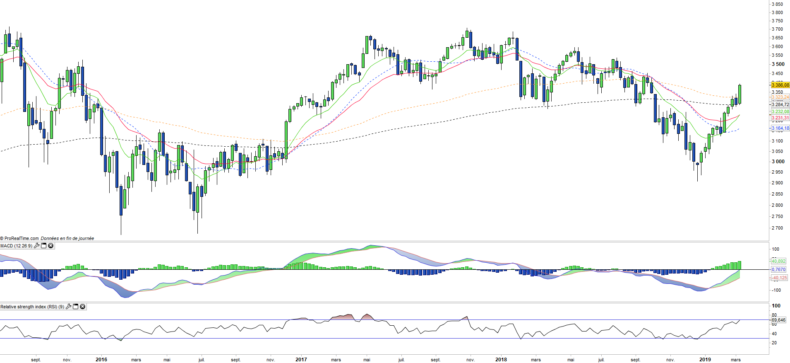SX5E - 18/03/19
Short Term trend: Positive (90/100)
Long Term trend: Positive (55/100)
(scores computed by our proprietary algorithms)
to access to our BUY / SELL signals
on Stocks, ETFs & Indices
Index profile & components
This index is dominated by the Franco-German couple, which represents around 70% of the index's capitalization, the remaining 30% mainly for the southern European countries (mainly Italy and Spain) as well as the Benelux countries.
The 10 largest stocks represent around 36% of the index and have a very large market capitalization of around €100bn including 4 German companies (Siemens, SAP, Linde and Allianz) and 3 French (Total, Sanofi and LVMH).
The index is fairly balanced from a sector point of view, with the most represented being financials (17%), followed by Industry (13%), and cyclical consumer goods (12%) and durable (11%) as well as health (10%).
As far as Eurozone stocks are concerned, there is no direct currency risk, however, for large global companies there is sensitivity to currencies including Euro / dollar in first place.
The Euro Stoxx 50 is representative of the euro area economy because of its sector weighting, which is less favorable to energy than in some national indices (such as the CAC40), while the financial sector (banks + insurance) remains a key compartment but does not reach the weight of the Italian or Spanish indices (around 33%).
The volatility of the Euro Stoxx 50 is rather lower than that of the national indices, due to geographical diversification, the absence of sectoral bias and the greater inertia due to the size of the market capitalizations.
If we compare the Euro stoxx 50 with the Stoxx 600, we will find a much more concentrated index on the core of the euro zone and large market capitalizations, also narrower geographically due to the absence of the United Kingdom, Switzerland and the Nordic countries. *
The Euro Stoxx 50 fell by 14.3% in 2017 but rebounded 12.8% in 2018, to be compared with a rise of 13.4% for the stoxx600 after a drop of 10.7% in 2017.
The Euro stoxx 50 was penalized in 2017 by the return of political problems, mainly in Italy, of which the populist government is openly opposed to Brussels, and in Germany with the growing fragility of Angela Merkel. The other political issue is that of the trade war initiated by D.Trump that threatens Europe directly towards the automotive sector and steel, and indirectly because of the potentially negative impact on global growth. The monetary policy of the ECB is also a determining factor.
Technical analysis
Monthly analysis
The monthly chart shows a bullish reversal almost validated by a return above moving averages. Oscillators become positive again, with the exception of the MACD, which remains a lagging indicator. The index must now confirm its installation above the moving averages by the upward crossing of the EMAS13 & 26, which would be the sign of a new wave of growth over the medium term.
Weekly analysis
On the weekly chart, we can see that the index has crossed the bearish line which marks the end of the correction which originated at the beginning of the year 2018. An upward crossing is taking place, operating between the EMAs13 & 26, and an acceleration of the positive trend is revealed by the technical oscillators that return to the high zones, almost entering overbought areas. A confirmation of the break of the bearish line, by a price stabilization would bode well for the next following weeks.
Country Breakdown
| France | 100% |
| Germany | 28% |
| Spain | 10% |
| Netherlands | 7% |
| United Kingdom | 7% |
| Italy | 5% |
| Others | 5% |
Sector Breakdown
| Financials | 17% |
| Industrials | 13% |
| Consumer discretionary | 12% |
| Consumer Staples | 11% |
| Health Care | 10% |
| Information technology | 10% |
| Materials | 9% |
| Others | 19% |
Principales composantes
| Total | 6% |
| SAP | 4% |
| Sanofi Aventis | 4% |
| Allianz | 4% |
| Linde | 3% |
| Siemens | 3% |
| LVMH | 3% |
| Unilever | 3% |
| ASML Holding | 3% |
| Banco Santander | 3% |


